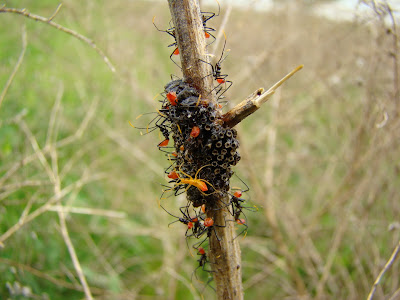Not Related.
The Wheel Bug is one of the largest earth-born 'true bugs' in North America. But even though it only grows up to 1.5 inches, it packs a mean bite. These bugs are very common in eastern North America, but even though these bugs are as common as stray dogs and sewer rats, people in the local area have never seen them before. The reason for this, is that they are well camouflaged and very shy of humans. Their weak wings allow them to make very loud clumsy flights that can be mistaken for a simple grasshopper. Sounds more likely for them to be the prey than the predator in any scenario right?
"Espanol?"
While that may be true, any prey of the Wheel Bug probably sleeps with one eye open, and a pistol on hand. These bugs probably have one of the most gruesome and disgusting methods of eating possible in the insect kingdom. If you thought a spider planting eggs that blow up everywhere into insects was horrible, you should probably stop reading.
 |
| Feel free to remove eyeballs after this point |
Oh wait, it was the green wire. That was pretty important too.
After the last few twitches are gone, the Wheel Bug proceeds to drain the victim's bodily fluids. Before you gasp that sigh of relief that it's shy of humans and probably not likely to bite us, let me inform you that they do bite humans when handled improperly. The bite can result in a wound that is extremely painful which can take months to heal completely along with a few battle scars. What that means is, you shouldn't go around looking for Wheel Bugs, placing them into a bags, and inserting the bag over your face. It's not really a recipe for success.
There's only one way to find out.
In the wild, they're known to be extremely vicious and uncaring. Some of creatures have showed cannibalistic behaviors, in which the female may feed on the male after they finish mating. These aren't pleasant creatures to have hanging around.
After the female leaves the dead male corpse, she begins to lay the eggs needed for the continuation of their species. The female will lay up to 40-200 small eggs on a tree twig around autumn, and die soon after. After the eggs are hatched, the little babies slowly become mature adults by next year during the summer to repeat the horrifying process.
Delicious.
Before you go to your local gardening shop to purchase as much pesticides as legally possible, hear me out. These bugs are technically beneficial for us, since their prey are mostly everyday pests. As said before, they avoid humans and try to hide from you whenever possible. If you somehow uncover thousands of Wheel Bugs under your front poach however, you'll be glad to know that they can produce a scent resembling the stink bug's. That foul scent will probably help you remember not rub your face into it.
"Dang it."









